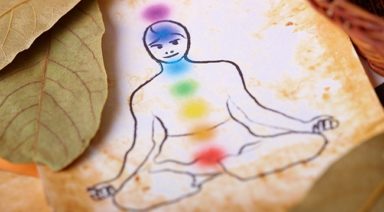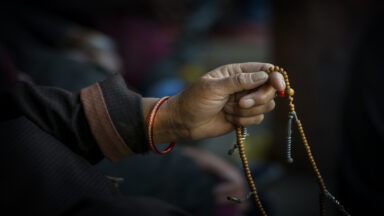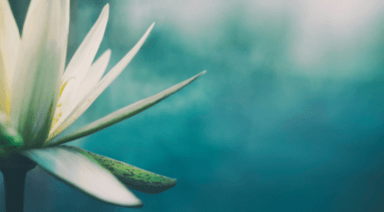Yoga For Your Doshas: Pitta

It’s one of those days: You had a project due at work and even though everything was going according to plan, someone had to take it a different direction at the last minute. Why did they not realize that you know best and things should be done your way? No wonder you are feeling a little short-tempered.
Coming home you notice that your dog chewed on your favourite new heels and you have a water stain on your beautiful teak coffee table from the tea bag your honey left laying around (again, not using a coaster). You feel the pressure building as steam comes out of your ears and your face turns a rich shade of scarlet. In short, your Pitta Dosha is stretched to its limits and your are off balance. You need to cool down.
According to Ayurveda, Yoga’s five thousand year old sister science, everything is governed by the natural elements of air, space, fire, water and earth. Each of these elements are associated with one, or in some cases two, of the Ayurvedic Doshas; the constitutional types. Vata Dosha, which I spoke about in part I of this series, is governed by space and air; Pitta Dosha is governed by fire and water, and Kapha Dosha is associated with water and earth.
Each of these Doshas are linked to certain qualities and can be pacified or aggravated by inner and outer circumstances that display these qualities.
What Dosha Are You?
In this article I will address Pitta, the Dosha that is governed predominantly by fire. If you are a little bit hot headed, have a “my way or the highway” attitude and would much rather go skiing down the slopes than lay in the tropical sun, you will want to read on.
Cool As A Cucumber: Food for Pitta
The flavors that sweeten a hot-headed and hot-bodied Pitta person are sweet, bitter and astringent. The tastes most aggravating to this type are salty, sour and pungent. The Pitta type tends toward acidity, and this may surface in heart burn and inflammatory conditions. Keeping a lightly alkaline blood environment is beneficial for Pitta and can be achieved by eating lots of yummy green leafy and alkaline veggies. Sweet and cooling fruit, such as sweet mangoes, apples berries and melon (particularly watermelon which is sweet and cooling in nature and has many healing benefits) are great choices for your diet. Sipping cool (never cold) water with a spritz of lime or lemon is a great way to keep a cool temper and keep your blood from boiling.
Pitta and Exercise
If you are a Pitta person, you likely love yourself some friendly competition both in your athletic endeavors, and in your personal and business life. Getting into a sport that requires a certain skill level and allows you to achieve and compete will likely give you a much needed outlet for your competitive and perfectionist work style. Competitive sports, such as running, cycling, playing tennis or racket ball, or even training for a body building competition, will give you a sense of purpose while jiving with your sense of drive and achievement.
There’s nothing wrong with being a little competitive, but you’ll want to consider a cooling or calming activity to balance your Dosha. Consider swimming (sure, compete if you must) as an active form of cooling refreshment with the added ability to push and challenge you. You will be a very happy Pitta camper if you allow yourself regular evening walks in the cooling moonlight, especially when sharing this down time with a sweet friend or loving partner.
Be Still: Meditation for Pitta
The Pitta person tends to be strong willed, determined and driven, and is often busy pondering and planning out new endeavors. If you are a Pitta planner and leader you may know how difficult it is for you to step out of busy mode to chill and relax. Meditation is a fantastic tool for Pittas who need to take a break from thinking and planning. Spend time calming your mind, and you’ll resurface feeling refreshed, with new ideas and increased problem solving skills.
The Pitta mind responds well to a meditation centered around soothing sound, smells, and colors. You may wish to listen to calming sounds of water or light a scented candle with a fresh cooling scent. Surrounding yourself with cool and light colors, or focusing your gaze on a cooling and calming Yantra, will guide your mind into a peaceful and tranquil state. Gentle or cooling Pranayama (breath work) such as Shitali or Sitkari Pranayama will also soothe your temper and focus your mind.
Pitta Yoga
If you are of high Pitta constitution, you’ll be drawn to hot yoga classes like a bee to honey. But remember that hot yoga, Vinyasa flow classes and traditional Ashtanga are styles best practiced in moderation.
The often A-type-ish Pitta person likes nothing more then working hard and reaping the benefits in business, their relationship, or in physical activity. Pitta tends to be of a strong and agile build and they like to move and sweat. To balance the challenge of the challenge with cooling calmness and to keep from over extending your limits, consider switching your Hot Yoga shorts for comfy casual wear and a Restorative or Yin style class once or twice per week. Forward bends and twists in particular are beneficial for Pitta as they are cooling and have a refreshing and rejuvenating effect on the blood and lymphatic system, thus allowing for optimal oxygen-blood exchange that is perfect for releasing built-up heat and tension from the midsection, while also fueling the mind.
The Pitta Motto
For you, dear Pitta type, relaxation should be your preferred motto. Staying calm, cool and collected while focusing and leading your team to success is the perfect balance. Remember to take time out for family, friends, loved ones and to enjoy the sweetness life has in store for you.
Spinning the Seven Sacred Centers: Ayurveda And the Chakra

The popular seven chakra system is well known in the West. Chakra, meaning vortex or wheel, are the sacred centers of spiritual transformation. Everything from clothing, home décor, and oracle cards sport the seven subtle centers with their associated rainbow of colors. Popular western literature corresponds each of the chakras with a fundamental human need. The root chakra, or Muladhara, is associated with the need for survival.
The second chakra, Swadisthana, is associated with the need for emotional flow, desire, and sexuality. The third chakra, Manipuri, is associated with self-worth. The fourth chakra, Anahata, is associated with love. The fifth chakra, Vishudhi, is associated with the need for expression. The sixth chakra, Ajna, is associated with insight and intuition. And the 7th or crown chakra, Sahasrara, is associated with connection to the divine.
However, ancient scriptures on the chakras such as the 16th-century text, Sat Chakra Nirupama, do not associate the seven chakras with fundamental human needs. This association was, to my knowledge, first made by Carl Jung in a series of lectures that have been republished as “The Psychology of Kundalini Yoga”(1932).
Likewise, the association of rainbow colors (red for the 1st chakra, orange for the 2nd and so on up to purple at the crown) was made first in the 1970s in a book titled “Nuclear Evolution: Discovery of the Rainbow Body,” by Christopher Hills. Ancient Sanskrit and Tibetan texts on chakras and the subtle energetic body (also known as the Pranamayakosha) have various numbers of chakras and a variety of color schemes that do not follow the “ROYGBIV” rainbow-schema.
For better or worse, the seven chakra system has become reified in yogic culture; the seven chakras system is the “standard” system with which most students and teachers of yoga are familiar with. Many students and teachers of yoga may also have some familiarity with Ayurveda, the “Science of Life.” Ayurveda is a system of earth-based holistic medicine that was originally developed in ancient India but has evolved for contemporary application. Ayurveda uses three archetypal categories, called doshas, to understand balance in the body.
These categories are Vata, Pitta, and Kapha. Vata is like air and ether. It is light, dry, and cold, and responsible for everything in the body that moves, communicates, and transports. Pitta is like fire. It is hot and slightly damp. Pitta is responsible for digestion, metabolism, and transformation in the body. Finally, Kapha is similar to earth and water. It is slow and stable. Wet and cold. Kapha is responsible for our stability, immunity, and strength.





































